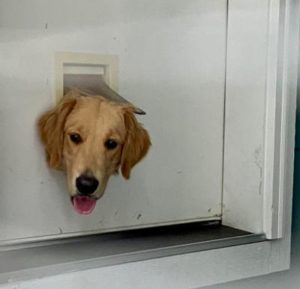Benefits are few while the drawbacks are many
The benefits of doggie doors, particularly those with flaps, permitting your precious pup to exit and enter your house in your absence, are, all too often, outweighed by their drawbacks.
 Your dog may bark more: With unlimited access to a doggie door, your dog can easily be tempted to run outside at the slightest sound and start barking. Before long, this behavior will become a pattern. The paw-tential results? Unhappy neighbors complaining about your dog’s excessive barking during the day when you’re not at home. Unhappier neighbors complaining about his randomly barking at night, eventually branding him a “nuisance barker”, thereby allowing Animal Control to intervene and fine you.
Your dog may bark more: With unlimited access to a doggie door, your dog can easily be tempted to run outside at the slightest sound and start barking. Before long, this behavior will become a pattern. The paw-tential results? Unhappy neighbors complaining about your dog’s excessive barking during the day when you’re not at home. Unhappier neighbors complaining about his randomly barking at night, eventually branding him a “nuisance barker”, thereby allowing Animal Control to intervene and fine you.
Your dog may escape: If granted unfettered 24-hour access to an inadequately fenced yard, he can readily escape (was that a squirrel he saw … a cat … another dog?), race into the road and be hit by a car, or even worse, run off, never to be seen again. Far too many agile and athletic dogs can, with the greatest of ease, leap a low fence and bolt. And for those less adept dogs, digging and burrowing UNDER the fence works equally as well.
Your dog may become aggressive: Another byproduct of incessive backyard barking should your dog roam about unsupervised, is frustration, and potentially aggression. When he sees other dogs go past or approach the fence — from mesh and chain link fences to widely spaced metal picket fences — not only will he begin to bark but, quite possibly, “fence fight” with them. He may even exhibit aggression towards people walking too near the fence, youngsters riding by on their bicycles and neighborhood children verbally teasing him or baiting him by poking their fingers through the spaces.
 If your dog shows any signs of either canine or human aggression – or simple boredom — keep him indoors when you’re not at home and have a dog walker take him for one or two walks a day. Or better still, hire an experienced pet sitter to bring him outside to the yard to potty, rewarding his “good behavior” and redirecting his attention at the first signs of aggression. The pet sitter can also have soft music playing to muffle some of the intrusive noises from outside, but most importantly, relieve his boredom by stimulating his brain and keeping him constructively engaged by solving puzzles of various kinds.
If your dog shows any signs of either canine or human aggression – or simple boredom — keep him indoors when you’re not at home and have a dog walker take him for one or two walks a day. Or better still, hire an experienced pet sitter to bring him outside to the yard to potty, rewarding his “good behavior” and redirecting his attention at the first signs of aggression. The pet sitter can also have soft music playing to muffle some of the intrusive noises from outside, but most importantly, relieve his boredom by stimulating his brain and keeping him constructively engaged by solving puzzles of various kinds.
Your dog may be stolen: Purebreds, in particular, are as desirable as they are expensive, and are, therefore, easy targets for those eager to make a profit by stealing and selling them. If your purebred dog has unsupervised access to the yard, especially if you’re not there, someone can stealthily unlatch the gate, open it or jump over the fence if it’s low enough, and leave with your dog in the blink of an eye.
Doggie doors are entry points for wild animals or uninvited guests (burglars): A door large enough to accommodate a large dog is an open invitation for a thief to squeeze through it when you’re away, perhaps pepper spray your pet and proceed to ransack your house. Or you could be home, asleep.
 Doggie doors are exit points for small children: Older toddlers can, all too easily, mimic the way your dog gets in and out of them and, if left unsupervised, escape just as easily into the backyard with potentially dangerous consequences.
Doggie doors are exit points for small children: Older toddlers can, all too easily, mimic the way your dog gets in and out of them and, if left unsupervised, escape just as easily into the backyard with potentially dangerous consequences.
In short, never leave YOUR cherished canine companion unattended outdoors when the safest place for him is, paws down, inside your house.
